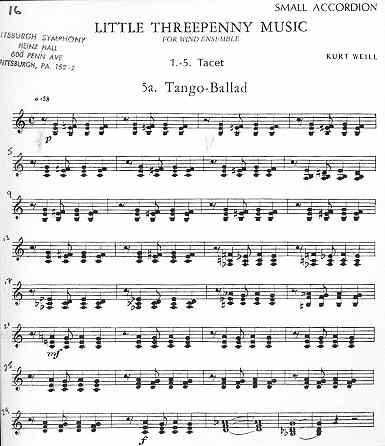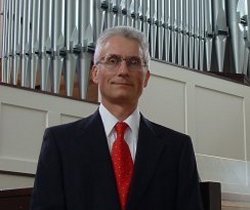ebruary 2003: Henry Doktorski performed as guest accordionist with the Pittsburgh Symphony Orchestra in four concerts of Kurt Weill's Music from the Threepenny Opera (arranged by Weill himself), directed by guest conductor G nther Herbig from February 7th to the 10th, 2003.
Written in 1928 by the great German composer Kurt Weill (1900-1950) in collaboration with lyricist Bertolt Brecht (1898-1956), the Threepenny Opera opened in Berlin to rave reviews. Utilizing the jazz and cabaret idioms of the time, the opera ran for five consecutive years and spawned a major motion picture. It finally came to the United States in 1954 where it had an astounding run in Greenwich Village, New York City, of over 2,600 performances.
Although the score calls for a bandone n, a small accordion is often used in its place. Doktorski said, "I was extremely pleased to use, in my performances with the PSO, an old, beat-up, twelve-bass instrument with a two-octave right-hand range! This was such a contrast with the instrument I customarily play with the orchestra: my 'Stradivarius' Victoria concert model, a 'Rolls Royce' of accordions with all the bells and whistles."
 Doktorski continued, "The small accordion, with only two sets of reeds: ranks of 8 foot and 16 foot reeds (in accordion parlance: the clarinet and bassoon reeds), had a timbre remarkable similar to the bandone n. In fact, the sound was more like a bandone n than any of my other accordions. (Professional accordionists usually own several instruments: one for solo concert work with dry-tuned reeds, another for a French Musette sound with wet-tuned reeds, and another instrument like my twelve-bass when a bandone n sound is needed.)"
Doktorski continued, "The small accordion, with only two sets of reeds: ranks of 8 foot and 16 foot reeds (in accordion parlance: the clarinet and bassoon reeds), had a timbre remarkable similar to the bandone n. In fact, the sound was more like a bandone n than any of my other accordions. (Professional accordionists usually own several instruments: one for solo concert work with dry-tuned reeds, another for a French Musette sound with wet-tuned reeds, and another instrument like my twelve-bass when a bandone n sound is needed.)"
The orchestration calls for two flutes (doubling on piccolo),alto and tenor saxophones (plus soprano sax), two clarinets, two bassoons, two trumpets, trombone, tuba, banjo (plus guitar), piano, accordion, drum set and timpani. The accordion part serves as an accompaniment and often doubles the banjo part. Only the right hand is called for. The accordion was used in four movements, the opening Overture, the Moritat of Mack the Knife, the Tango Ballad and the Finale.
The first performance was held at the Scottish Rite Cathedral in Newcastle, Pennsylvania; the final three were held at the home of the Pittsburgh Symphony Orchestra: the Heinz Center for the Performing Arts in Pittsburgh.




Doktorski continued, "The small accordion, with only two sets of reeds: ranks of 8 foot and 16 foot reeds (in accordion parlance: the clarinet and bassoon reeds), had a timbre remarkable similar to the bandone n. In fact, the sound was more like a bandone n than any of my other accordions. (Professional accordionists usually own several instruments: one for solo concert work with dry-tuned reeds, another for a French Musette sound with wet-tuned reeds, and another instrument like my twelve-bass when a bandone n sound is needed.)"